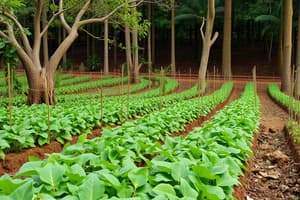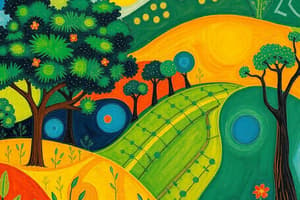Podcast
Questions and Answers
What is agroforestry?
What is agroforestry?
Planting trees with crops and livestock.
When was the term 'agroforestry' coined?
When was the term 'agroforestry' coined?
In the late 1970s.
What are the three types of agroforestry systems?
What are the three types of agroforestry systems?
- Agrisilvicultural system
- Silvopastoral system
- Agrosylvopastoral system
- All of the above (correct)
Agroforestry is a simple land use system.
Agroforestry is a simple land use system.
What is one benefit of agroforestry?
What is one benefit of agroforestry?
Who established the International Council for Research in Agroforestry?
Who established the International Council for Research in Agroforestry?
Agroforestry merges agriculture and _______.
Agroforestry merges agriculture and _______.
What does agroforestry manage?
What does agroforestry manage?
According to Nair, when was agroforestry defined in various ways?
According to Nair, when was agroforestry defined in various ways?
What are the ecological interactions observed in agroforestry systems?
What are the ecological interactions observed in agroforestry systems?
How do agroforestry systems enhance economic benefits for land users?
How do agroforestry systems enhance economic benefits for land users?
In what ways does agroforestry support environmental sustainability?
In what ways does agroforestry support environmental sustainability?
What is the significance of temporal sequences in agroforestry?
What is the significance of temporal sequences in agroforestry?
Discuss the role of woody perennials in enhancing land management in agroforestry.
Discuss the role of woody perennials in enhancing land management in agroforestry.
What does ICRAF's definition of agroforestry emphasize about land-use systems?
What does ICRAF's definition of agroforestry emphasize about land-use systems?
Why is the integration of crops and livestock important in agroforestry systems?
Why is the integration of crops and livestock important in agroforestry systems?
Explain how agroforestry contributes to social benefits for local communities.
Explain how agroforestry contributes to social benefits for local communities.
What innovative concept related to agroforestry did J. Russell Smith advocate for in the early 20th century?
What innovative concept related to agroforestry did J. Russell Smith advocate for in the early 20th century?
How did New Zealand contribute to the integration of agriculture and forestry?
How did New Zealand contribute to the integration of agriculture and forestry?
Describe the agroforestry success story observed in Italy involving poplar trees.
Describe the agroforestry success story observed in Italy involving poplar trees.
What advantages were observed in northern China from intercropping hybrid poplar with other crops?
What advantages were observed in northern China from intercropping hybrid poplar with other crops?
What primary challenge does the seasonality of temperate regions pose for agroforestry practices?
What primary challenge does the seasonality of temperate regions pose for agroforestry practices?
Identify two common agroforestry systems that are practiced in temperate regions.
Identify two common agroforestry systems that are practiced in temperate regions.
What socioeconomic factors can influence agroforestry practices in temperate regions?
What socioeconomic factors can influence agroforestry practices in temperate regions?
What was the role of historical perspectives in the development of temperate agroforestry?
What was the role of historical perspectives in the development of temperate agroforestry?
What are the main goals of the 2011-2016 Strategic Framework regarding agroforestry?
What are the main goals of the 2011-2016 Strategic Framework regarding agroforestry?
How did the European Union support agroforestry in 2001 and subsequently?
How did the European Union support agroforestry in 2001 and subsequently?
What role did the Common Agricultural Policy play in the evolution of agroforestry in Europe?
What role did the Common Agricultural Policy play in the evolution of agroforestry in Europe?
What are Land care and the Sustainable Farming Fund's perspectives on agroforestry in Australia and New Zealand?
What are Land care and the Sustainable Farming Fund's perspectives on agroforestry in Australia and New Zealand?
Why is classification of agroforestry systems considered important with modernization?
Why is classification of agroforestry systems considered important with modernization?
What aspect of agroforestry does the new CAP of 2014 emphasize as a solution?
What aspect of agroforestry does the new CAP of 2014 emphasize as a solution?
In what ways do agroforestry systems differ globally?
In what ways do agroforestry systems differ globally?
How do agroforestry initiatives influence agricultural practices toward sustainability?
How do agroforestry initiatives influence agricultural practices toward sustainability?
Flashcards
Agroforestry
Agroforestry
A land-use system that combines agriculture (crops and livestock) and forestry (trees and shrubs) by integrating them on the same land.
Agrisilvicultural System
Agrisilvicultural System
The practice of integrating trees with crops on the same land.
Silvopastoral System
Silvopastoral System
The practice of combining trees with livestock on the same land.
Agrosylvopastoral System
Agrosylvopastoral System
Signup and view all the flashcards
Social Benefits of Agroforestry
Social Benefits of Agroforestry
Signup and view all the flashcards
Environmental Benefits of Agroforestry
Environmental Benefits of Agroforestry
Signup and view all the flashcards
Economic Benefits of Agroforestry
Economic Benefits of Agroforestry
Signup and view all the flashcards
Challenges of Agroforestry
Challenges of Agroforestry
Signup and view all the flashcards
Historical Context of Agroforestry
Historical Context of Agroforestry
Signup and view all the flashcards
Agroclimatic Factors for Agroforestry
Agroclimatic Factors for Agroforestry
Signup and view all the flashcards
Agroforestry in Developing Nations
Agroforestry in Developing Nations
Signup and view all the flashcards
Agroforestry's Growing Popularity
Agroforestry's Growing Popularity
Signup and view all the flashcards
J. Russell Smith
J. Russell Smith
Signup and view all the flashcards
Farm Forestry
Farm Forestry
Signup and view all the flashcards
Intercropping
Intercropping
Signup and view all the flashcards
Temperate Agroforestry
Temperate Agroforestry
Signup and view all the flashcards
Socioeconomic Factors in Temperate Agroforestry
Socioeconomic Factors in Temperate Agroforestry
Signup and view all the flashcards
ICRAF's Definition of Agroforestry
ICRAF's Definition of Agroforestry
Signup and view all the flashcards
ICRAF's Contribution to Agroforestry
ICRAF's Contribution to Agroforestry
Signup and view all the flashcards
European Support for Agroforestry
European Support for Agroforestry
Signup and view all the flashcards
Article 44 of the European Commission
Article 44 of the European Commission
Signup and view all the flashcards
CAP's Vision for Agroforestry
CAP's Vision for Agroforestry
Signup and view all the flashcards
Agroforestry Initiatives in Australia and New Zealand
Agroforestry Initiatives in Australia and New Zealand
Signup and view all the flashcards
Diversity of Agroforestry Systems
Diversity of Agroforestry Systems
Signup and view all the flashcards
Classification of Agroforestry Systems
Classification of Agroforestry Systems
Signup and view all the flashcards
Study Notes
Introduction to Agroforestry
- Agroforestry combines the practices of agriculture and forestry by integrating trees with crops and livestock.
- The term "agroforestry" was coined in the late 1970s, marking a significant shift towards modern land-use systems.
- The establishment of the International Council for Research in Agroforestry in 1978 (now known as the World Agroforestry Centre) helped formalize and advance agroforestry practices.
Definition and Understanding of Agroforestry
- Defined as a system that merges elements of agriculture (crops and livestock) with forestry (trees and shrubs).
- Agriculture focuses on growing crops and raising animals for food and resources, while forestry involves managing and conserving forested areas.
- Agroforestry systems result in more ecological and economic interactions compared to monoculture systems, enhancing land productivity and resilience.
Types of Agroforestry Systems
- Agrisilvicultural system: Integration of trees with crops.
- Silvopastoral systems: Combination of trees and livestock.
- Agrosylvopastoral system: Integrates all three components—trees, crops, and livestock.
Benefits of Agroforestry
- Social Benefits: Enhances food availability, income, and health for rural populations.
- Environmental Benefits: Improves resource management, such as soil and water conservation.
- Economic Benefits: Increases productivity and profitability compared to monocrop systems.
Limitations of Agroforestry
- Challenges include complexity in management, potential conflicts between tree and crop/livestock needs, and requirement for knowledge and training among land users.
Historical Context
- Agroforestry practices have been used for centuries but were systematized in modern definitions and frameworks in the late 20th century.
Conclusion
- Agroforestry is viewed as a dynamic and ecologically-based system that promotes sustainable resource management through the harmonious integration of trees, crops, and livestock.
Agroclimatic Factors and Agroforestry Potential
- Favorable conditions in tropics and subtropics promote diverse species growth and traditional agroforestry systems.
- Agroforestry offers solutions for land use and socioeconomic challenges in developing nations.
- Attracts attention from farmers and researchers for sustainable agricultural practices.
Historical Context of Agroforestry
- J. Russell Smith recognized tree-based agriculture's importance in the U.S. (1909) and advocated for interplanting crops with legumes and animals (1914).
- New Zealand pioneered "farm forestry" to reconcile land use conflicts between agriculture and forestry.
- Successful intercropping in Italy with maize, legumes, and poplar during the first four years.
- Northern China’s hybrid poplar cultivation combined with sesame, soybean, peanuts, and cotton demonstrated significant benefits in early years.
Characteristics of Temperate Agroforestry
- Distinct warm and cold seasons limit year-round crop cultivation and variety of systems.
- Common practices include agrisilvicultural (windbreaks, shelterbelts) and silvopastoral (mixing livestock with woodlands) systems.
- Socioeconomic factors influence the development and adoption of agroforestry in temperate regions.
Definition and Importance of Agroforestry
- Agroforestry integrates trees and agricultural practices, enhancing land resilience and productivity compared to monoculture.
- Involves using woody perennials alongside crops and animals, with potential for spatial and temporal arrangements.
- Aims for ecological and economic interactions, promoting sustainable social, economic, and environmental benefits.
ICRAF and Agroforestry Recognition
- ICRAF defines agroforestry as integrating woody perennials with crops and animals, leading to sustainability.
- Contributions from ICRAF have helped establish agroforestry as an agricultural science branch.
- The 2011-2016 Strategic Framework focused on increasing agroforestry adoption and understanding its tools and applications.
European Integration and Support
- In Europe, tree-based intercropping systems gained access to funding under the Common Agricultural Policy (CAP) since 2001.
- The 2004 European Commission's Article 44 initiated support for agroforestry practices.
- The 2014 CAP positions agroforestry as a strategy for enhancing farm biodiversity and improving rural areas.
Initiatives in Australia and New Zealand
- Australia and New Zealand are recognizing agroforestry's benefits through programs like Land Care and the Sustainable Farming Fund.
- Promotes sustainable agricultural practices aligned with agroforestry initiatives.
Classification of Agroforestry Systems
- Agroforestry systems worldwide vary, with some involving only trees and crops, while others include animals or pasture.
- Modernization necessitates a comprehensive classification of these diverse systems.
Studying That Suits You
Use AI to generate personalized quizzes and flashcards to suit your learning preferences.
Description
Explore the fundamentals of agroforestry, including its history, definitions, and systems. Learn how this innovative practice integrates agriculture and forestry to enhance productivity and sustainability. Discover the various types of agroforestry systems and their ecological benefits.




